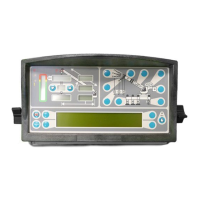
Do you have a question about the GREER Company MicroGuard RCI 510 and is the answer not in the manual?
| Brand | GREER Company |
|---|---|
| Model | MicroGuard RCI 510 |
| Category | Industrial Equipment |
| Language | English |
Diagram illustrating the system's architecture and component connections.
Details visual and auditory feedback during the self-test sequence.
Guides fault diagnosis for Anti Two-Block alarm issues.
Steps to verify boom extension accuracy and troubleshoot errors.
Procedures to check and calibrate main boom radius measurements.
Illustrates the pressure monitor display and expected values.
Identifies the computer unit and its role in the system.
Details the function and replacement of the FUS1 fuse.
Provides procedures for checking the pressure sensor readings.
Illustrates the pressure monitor display and expected values.
Detailed instructions for safely removing the computer unit.
Step-by-step guide for installing the computer unit.
Procedures for powering up and calibrating the unit after installation.
Illustrates the main display console and its layout.
Tips for optimizing display readability and addressing contrast issues.
Explains the operation and troubleshooting of the remote bar graph's LEDs.
Details how to adjust and use the brightness control feature.
Diagram showing the internal components of the extension reel assembly.
Diagram illustrating the correct cable layering on the extension reel.
Wiring diagram for the sensor baseplate assembly.
Steps to set the physical zero for the extension sensor potentiometer.
How to calibrate the zero setting of the extension sensor potentiometer.
Diagram of the sensor assembly, highlighting the pendulum.
Wiring diagram for the sensor baseplate assembly.
Steps to set the physical zero for the angle sensor potentiometer.
How to calibrate the zero setting of the angle sensor potentiometer.
Details the extension reel-off cable and its function.
Diagram showing the reel-off cable connection.
Diagram illustrating the slip-ring assembly and its connections.
Wiring details for the sensor assembly terminal block.
Wiring details for the signal cable terminal block.
Diagram illustrating the swing sensor and its connections.
How to check and set the zero angle for the swing sensor.
How to check and set the direction for the swing sensor.